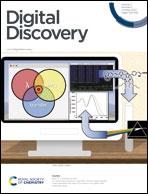Metric geometry tools for automatic structure phase map generation†
Abstract
Extracting a phase map that provides a hierarchical summary of high-throughput experiments is a long-standing bottleneck for the modern goal of achieving automation and acceleration in material discovery. A phase map that underpins the inherent properties of materials is typically denoted using a composition-structure map but can be extended to other relevant parameters such as synthesis. This paper describes a computational statistical tool to efficiently obtain a phase map from multi-scale experimental measurement profiles obtained from high-throughput measurements. We motivate the construction of a phase map as the problem of learning the underlying metric geometry defined by a set of templates in infinite-dimensional function spaces. We provide a statistical analysis tool to obtain a phase map as an asymptotic of the diffusion of resulting distance functions on the composition. Using examples from small-angle X-ray scattering experiments of polymer blend systems, we show that learned metric geometry can efficiently differentiate ordered phase regions with shifted, missing, and broad Bragg peaks along with features related to non-Bragg behavior of soft-matter systems. The metric geometry allows us to define a shape distance between scattering profiles invariant to phase-independent transformations thus valuable for obtaining a phase map. We also apply the methodology to benchmark experimental diffraction data to showcase potential utility and broad applicability.



 Please wait while we load your content...
Please wait while we load your content...